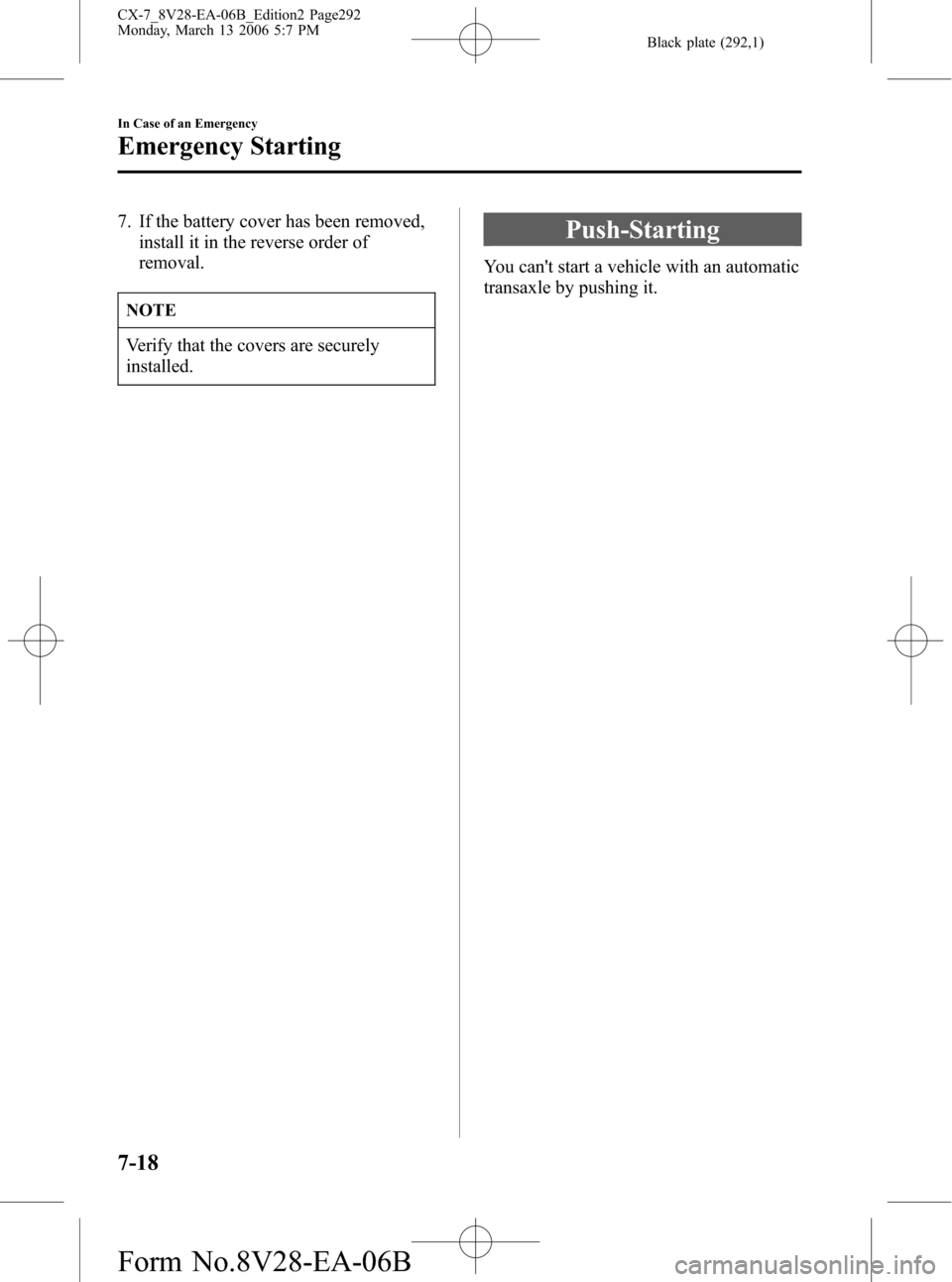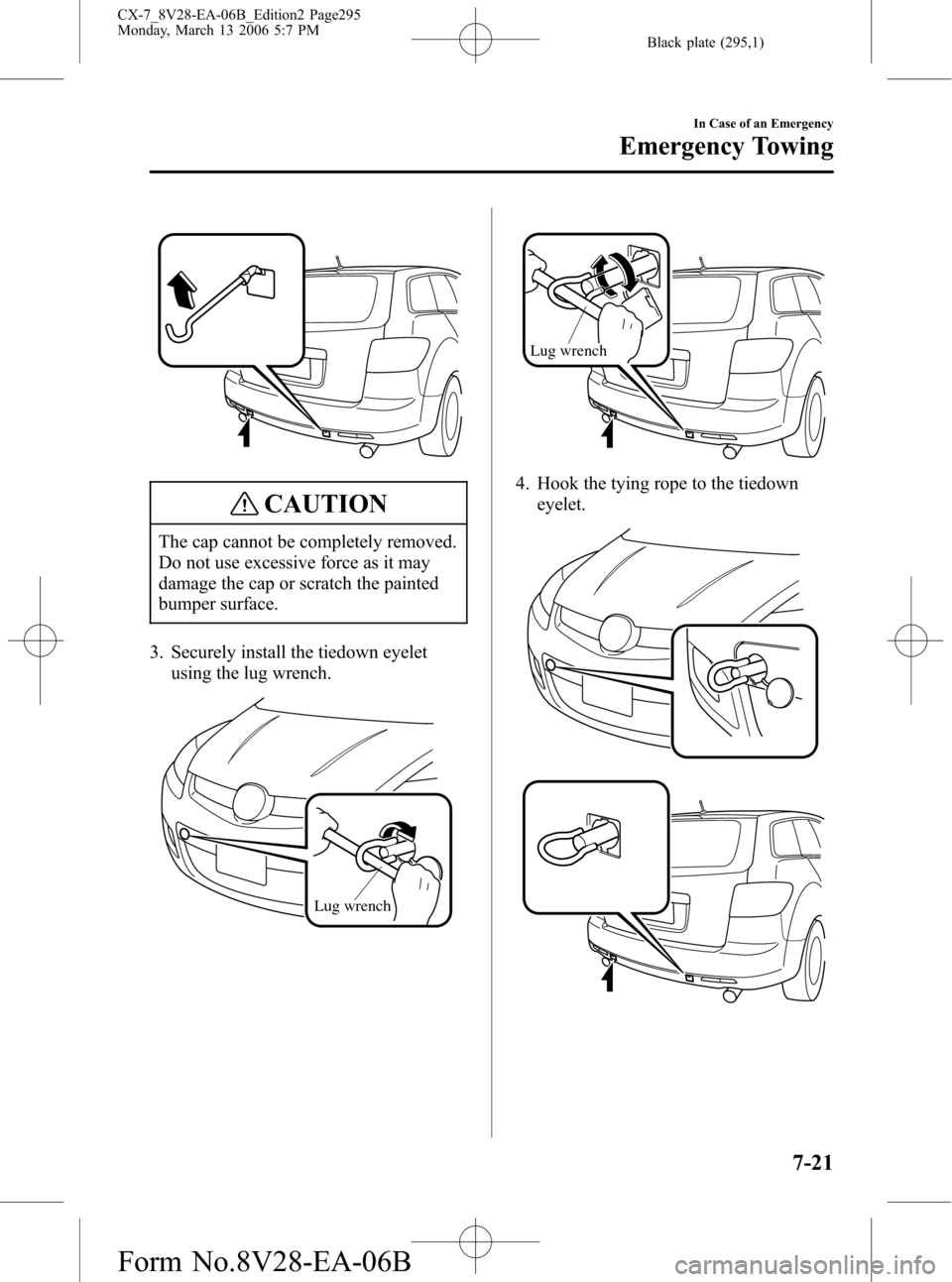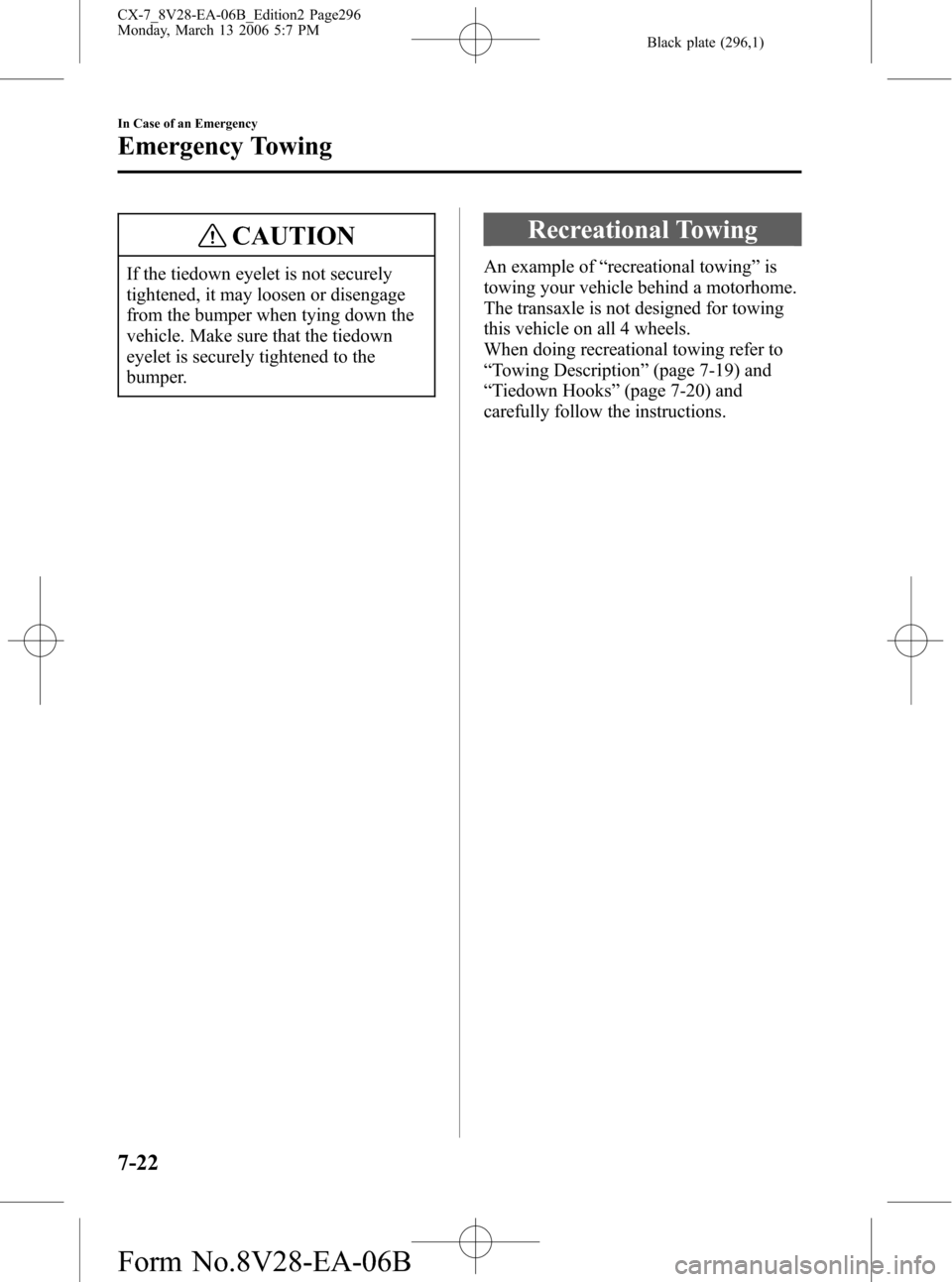MAZDA MODEL CX-7 2007 Owners Manual (in English)
Manufacturer: MAZDA, Model Year: 2007, Model line: MODEL CX-7, Model: MAZDA MODEL CX-7 2007Pages: 406, PDF Size: 6.11 MB
Page 291 of 406

Black plate (291,1)
Connect cables in numerical order and disconnect in reverse order
Booster battery Jumper
cablesDischarged battery
1. Remove the battery cover.
2. Make sure the booster battery is 12 V
and that its negative terminal is
grounded.
3. If the booster battery is in another
vehicle, don't allow both vehicles to
touch. Turn off the engine of the
vehicle with the booster battery and all
unnecessary electrical loads in both
vehicles.4. Connect the jumper cables in the exact
sequence as in the illustration.
lConnect one end of a cable to the
positive terminal on the discharged
battery (1).
lAttach the other end to the positive
terminal on the booster battery (2).
lConnect one end of the other cable
to the negative terminal of the
booster battery (3).
lConnect the other end to a solid,
stationary, exposed metallic point
(for example, the engine mounting
bolt facing the front of the vehicle,
as shown in the figure) away from
the discharged battery (4).
5. Start the engine of the booster vehicle
and run it a few minutes. Then start the
engine of the other vehicle.
6. When finished, carefully disconnect the
cables in the reverse order described in
the illustration.
In Case of an Emergency
Emergency Starting
7-17
CX-7_8V28-EA-06B_Edition2 Page291
Monday, March 13 2006 5:7 PM
Form No.8V28-EA-06B
Page 292 of 406

Black plate (292,1)
7. If the battery cover has been removed,
install it in the reverse order of
removal.
NOTE
Verify that the covers are securely
installed.
Push-Starting
You can't start a vehicle with an automatic
transaxle by pushing it.
7-18
In Case of an Emergency
Emergency Starting
CX-7_8V28-EA-06B_Edition2 Page292
Monday, March 13 2006 5:7 PM
Form No.8V28-EA-06B
Page 293 of 406

Black plate (293,1)
Towing Description
We recommend that towing be done only
by an Authorized Mazda Dealer or a
commercial tow-truck service.
Proper lifting and towing are necessary to
prevent damage to the vehicle.
Particularly when towing a AWD vehicle,
where all the wheels are connected to the
drive train, proper transporting of the
vehicle is absolutely essential to avoid
damaging the drive system. Government
and local laws must be followed.
Wheel dollies
A towed 2WD vehicle should have its
front wheels off the ground. If excessive
damage or other conditions prevent this,
use wheel dollies.
When towing a 2WD vehicle with the rear
wheels on the ground, release the parking
brake.
A towed AWD vehicle must have all its
wheels off the ground.
CAUTION
Don't tow the vehicle pointed backward
with driving wheels on the ground. This
may cause internal damage to the
transaxle.
CAUTION
Don't tow with sling-type equipment.
This could damage your vehicle. Use
wheel-lift or flatbed equipment.
In Case of an Emergency
Emergency Towing
7-19
CX-7_8V28-EA-06B_Edition2 Page293
Monday, March 13 2006 5:7 PM
Form No.8V28-EA-06B
Page 294 of 406

Black plate (294,1)
WARNING
Towing a AWD Vehicle:
Towing a AWD vehicle with either the
front or rear wheels on the ground is
dangerous as the drive train could be
damaged, or the vehicle could trail
away from the tow truck and cause an
accident. Always tow a AWD vehicle
with all four wheels off the ground. If
the drive train has been damaged,
transport the vehicle on a flat bed
truck.
Tiedown Hooks
CAUTION
Don't use the tiedown hooks under the
front and rear for towing.
They are designed ONLY for tying
down the vehicle when it's being
transported. Using them for towing will
damage the bumper.
qTiedown Hooks
1. Remove the tiedown eyelet, lug
wrench, and jack lever from the trunk
(page 7-3).
2. Wrap the jack lever with a soft cloth to
prevent damage to the bumper and
open the cap located on the front and
rear bumper.
7-20
In Case of an Emergency
Emergency Towing
CX-7_8V28-EA-06B_Edition2 Page294
Monday, March 13 2006 5:7 PM
Form No.8V28-EA-06B
Page 295 of 406

Black plate (295,1)
CAUTION
The cap cannot be completely removed.
Do not use excessive force as it may
damage the cap or scratch the painted
bumper surface.
3. Securely install the tiedown eyelet
using the lug wrench.
Lug wrench
Lug wrench
4. Hook the tying rope to the tiedown
eyelet.
In Case of an Emergency
Emergency Towing
7-21
CX-7_8V28-EA-06B_Edition2 Page295
Monday, March 13 2006 5:7 PM
Form No.8V28-EA-06B
Page 296 of 406

Black plate (296,1)
CAUTION
If the tiedown eyelet is not securely
tightened, it may loosen or disengage
from the bumper when tying down the
vehicle. Make sure that the tiedown
eyelet is securely tightened to the
bumper.
Recreational Towing
An example of“recreational towing”is
towing your vehicle behind a motorhome.
The transaxle is not designed for towing
this vehicle on all 4 wheels.
When doing recreational towing refer to
“Towing Description”(page 7-19) and
“Tiedown Hooks”(page 7-20) and
carefully follow the instructions.
7-22
In Case of an Emergency
Emergency Towing
CX-7_8V28-EA-06B_Edition2 Page296
Monday, March 13 2006 5:7 PM
Form No.8V28-EA-06B
Page 297 of 406

Black plate (297,1)
8Maintenance and Care
How to keep your Mazda in top condition.
Introduction .................................................................................. 8-2
Introduction ............................................................................... 8-2
Scheduled Maintenance ................................................................ 8-3
Scheduled Maintenance ............................................................ 8-3
Owner Maintenance ..................................................................... 8-8
Owner Maintenance Schedule .................................................. 8-8
Owner Maintenance Precautions ............................................... 8-9
Engine Compartment Overview .............................................. 8-11
Engine Oil ............................................................................... 8-12
Engine Coolant ....................................................................... 8-14
Brake Fluid ............................................................................. 8-16
Power Steering Fluid ............................................................... 8-17
Automatic Transaxle Fluid (ATF) ........................................... 8-18
Washer Fluid ........................................................................... 8-20
Body Lubrication .................................................................... 8-21
Wiper Blades ........................................................................... 8-21
Battery ..................................................................................... 8-25
Tires ........................................................................................ 8-28
Light Bulbs ............................................................................. 8-33
Fuses ....................................................................................... 8-40
Appearance Care ........................................................................ 8-45
How to Minimize Environmental Paint Damage .................... 8-45
Exterior Care ........................................................................... 8-47
Interior Care ............................................................................ 8-50
8-1
CX-7_8V28-EA-06B_Edition2 Page297
Monday, March 13 2006 5:7 PM
Form No.8V28-EA-06B
Page 298 of 406

Black plate (298,1)
Introduction
Be extremely careful and prevent injury to yourself and others or damage to your vehicle
when using this manual for inspection and maintenance.
If you're unsure about any procedure it describes, we strongly urge you to have a reliable
and qualified service shop perform the work, preferably an Authorized Mazda Dealer.
Factory-trained Mazda technicians and genuine Mazda parts are best for your vehicle.
Without this expertise and the parts that have been designed and made especially for your
Mazda, inadequate, incomplete, and insufficient servicing may result in problems. This
could lead to vehicle damage or an accident and injuries.
For expert advice and quality service, consult an Authorized Mazda Dealer.
The owner should retain evidence that proper maintenance has been performed as
prescribed.
Claims against the warranty resulting from lack of maintenance, as opposed to defective
materials or authorized Mazda workmanship, will not be honored.
Any auto repair shop using parts equivalent to your Mazda's original equipment may
perform maintenance.But we recommend that it always be done by an Authorized
Mazda Dealer using genuine Mazda parts.
8-2
Maintenance and Care
Introduction
CX-7_8V28-EA-06B_Edition2 Page298
Monday, March 13 2006 5:7 PM
Form No.8V28-EA-06B
Page 299 of 406

Black plate (299,1)
Scheduled Maintenance
Follow Schedule 1 if the vehicle is operated mainly where none of the following conditions
apply.
If any do apply, follow Schedule 2 (Canada and Puerto Rico residents follow Schedule 2).
lRepeated short-distance driving
lDriving in dusty conditions
lDriving with extended use of brakes
lDriving in areas where salt or other corrosive materials are being used
lDriving on rough or muddy roads
lExtended periods of idling or low-speed operation
lDriving for long periods in cold temperatures or extremely humid climates
NOTE
After the prescribed period, continue to follow the described maintenance at the
recommended intervals.
Maintenance and Care
Scheduled Maintenance
8-3
CX-7_8V28-EA-06B_Edition2 Page299
Monday, March 13 2006 5:7 PM
Form No.8V28-EA-06B
Page 300 of 406

Black plate (300,1)
qSchedule 1
Maintenance IntervalNumber of months or kilometers (miles), whichever comes first
Months 6 12 18 24 30 36 42 48
×1000 km 12 24 36 48 60 72 84 96
×1000 miles 7.5 15 22.5 30 37.5 45 52.5 60
ENGINE
Engine valve clearanceAudible inspect every 120,000 km (75,000 miles), if noisy,
adjust
Drive belts (tension) I
Engine oilRRRRRRRR
Engine oil filterRRRRRRRR
COOLING SYSTEM
Engine coolantFL22 type
*1Replace at first 192,000 km (120,000 miles) or 10 years; after
that, every 96,000 km (60,000 miles) or 5 years
OthersReplace at first 96,000 km (60,000 miles) or 4 years; after that,
every 2 years
FUEL SYSTEM
Air filter R
Fuel lines and hoses
*2II
Hoses and tubes for emission*2I
IGNITION SYSTEM
Spark plugs Replace every 120,000 km (75,000 miles)
CHASSIS and BODY
Brake lines, hoses and connections I I
Disc brakesIIII
Tire (Rotation) Rotate every 12,000 km (7,500 miles)
Steering operation and linkages I I
Front and rear suspension and ball joints I I
Rear differential oil
*3*4
Transfer oil*4
Driveshaft dust boots I I
Exhaust system and heat shields Inspect every 72,000 km (45,000 miles) or 5 years
All locks and hingesLLLLLLLL
8-4
Maintenance and Care
Scheduled Maintenance
CX-7_8V28-EA-06B_Edition2 Page300
Monday, March 13 2006 5:7 PM
Form No.8V28-EA-06B